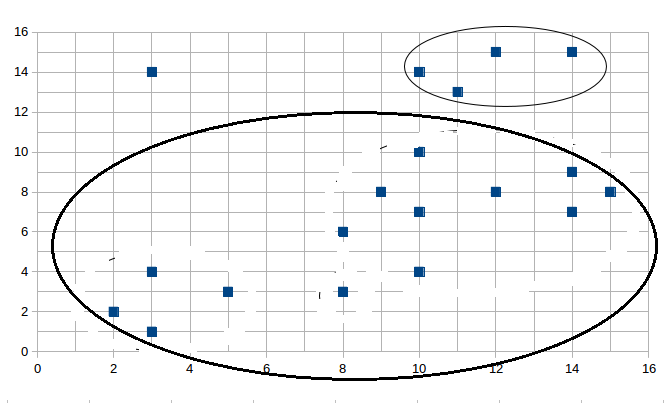dbscan基于密度的空间聚类算法
参考文献:百度百科 http://baike.baidu.com
我的算法库:https://github.com/linyiqun/lyq-algorithms-lib
算法介绍
说到聚类算法,大家如果有看过我写的一些关于机器学习的算法文章,一定都这类算法不会陌生,之前将的是划分算法(K均值算法)和层次聚类算法(BIRCH算法),各有优缺点和好坏。本文所述的算法是另外一类的聚类算法,他能够克服BIRCH算法对于形状的限制,因为BIRCH算法偏向于聚簇球形的聚类形成,而dbscan采用的是基于空间的密度的原理,所以可以适用于任何形状的数据聚类实现。
算法原理
在介绍算法原理之前,先介绍几个dbscan算法中的几个概念定义:
Ε领域:给定对象半径为Ε内的区域称为该对象的Ε领域;
核心对象:如果给定对象Ε领域内的样本点数大于等于MinPts,则称该对象为核心对象;
直接密度可达:对于样本集合D,如果样本点q在p的Ε领域内,并且p为核心对象,那么对象q从对象p直接密度可达。
密度可达:对于样本集合D,给定一串样本点p1,p2….pn,p= p1,q= pn,假如对象pi从pi-1直接密度可达,那么对象q从对象p密度可达。
密度相连:存在样本集合D中的一点o,如果对象o到对象p和对象q都是密度可达的,那么p和q密度相联。
下面是算法的过程(可能说的不是很清楚):
1、扫描原始数据,获取所有的数据点。
2、遍历数据点中的每个点,如果此点已经被访问(处理)过,则跳过,否则取出此点做聚类查找。
3、以步骤2中找到的点P为核心对象,找出在E领域内所有满足条件的点,如果个数大于等于MinPts,则此点为核心对象,加入到簇中。
4、再次P为核心对象的簇中的每个点,进行递归的扩增簇。如果P点的递归扩增结束,再次回到步骤2。
5、算法的终止条件为所有的点都被访问(处理过)。
算法可以理解为是一个DFS的深度优先扩展。
算法的实现
算法的输入Input(格式(x, y)):
- 2 2
- 3 1
- 3 4
- 3 14
- 5 3
- 8 3
- 8 6
- 9 8
- 10 4
- 10 7
- 10 10
- 10 14
- 11 13
- 12 8
- 12 15
- 14 7
- 14 9
- 14 15
- 15 8
坐标点类Point.java:
- package DataMining_DBSCAN;
- /**
- * 坐标点类
- *
- * @author lyq
- *
- */
- public class Point {
- // 坐标点横坐标
- int x;
- // 坐标点纵坐标
- int y;
- // 此节点是否已经被访问过
- boolean isVisited;
- public Point(String x, String y) {
- this.x = (Integer.parseInt(x));
- this.y = (Integer.parseInt(y));
- this.isVisited = false;
- }
- /**
- * 计算当前点与制定点之间的欧式距离
- *
- * @param p
- * 待计算聚类的p点
- * @return
- */
- public double ouDistance(Point p) {
- double distance = 0;
- distance = (this.x - p.x) * (this.x - p.x) + (this.y - p.y)
- * (this.y - p.y);
- distance = Math.sqrt(distance);
- return distance;
- }
- /**
- * 判断2个坐标点是否为用个坐标点
- *
- * @param p
- * 待比较坐标点
- * @return
- */
- public boolean isTheSame(Point p) {
- boolean isSamed = false;
- if (this.x == p.x && this.y == p.y) {
- isSamed = true;
- }
- return isSamed;
- }
- }
算法工具类DNSCANTool.java:
- package DataMining_DBSCAN;
- import java.io.BufferedReader;
- import java.io.File;
- import java.io.FileReader;
- import java.io.IOException;
- import java.text.MessageFormat;
- import java.util.ArrayList;
- /**
- * DBSCAN基于密度聚类算法工具类
- *
- * @author lyq
- *
- */
- public class DBSCANTool {
- // 测试数据文件地址
- private String filePath;
- // 簇扫描半径
- private double eps;
- // 最小包含点数阈值
- private int minPts;
- // 所有的数据坐标点
- private ArrayList<Point> totalPoints;
- // 聚簇结果
- private ArrayList<ArrayList<Point>> resultClusters;
- //噪声数据
- private ArrayList<Point> noisePoint;
- public DBSCANTool(String filePath, double eps, int minPts) {
- this.filePath = filePath;
- this.eps = eps;
- this.minPts = minPts;
- readDataFile();
- }
- /**
- * 从文件中读取数据
- */
- public void readDataFile() {
- File file = new File(filePath);
- ArrayList<String[]> dataArray = new ArrayList<String[]>();
- try {
- BufferedReader in = new BufferedReader(new FileReader(file));
- String str;
- String[] tempArray;
- while ((str = in.readLine()) != null) {
- tempArray = str.split(" ");
- dataArray.add(tempArray);
- }
- in.close();
- } catch (IOException e) {
- e.getStackTrace();
- }
- Point p;
- totalPoints = new ArrayList<>();
- for (String[] array : dataArray) {
- p = new Point(array[0], array[1]);
- totalPoints.add(p);
- }
- }
- /**
- * 递归的寻找聚簇
- *
- * @param pointList
- * 当前的点列表
- * @param parentCluster
- * 父聚簇
- */
- private void recursiveCluster(Point point, ArrayList<Point> parentCluster) {
- double distance = 0;
- ArrayList<Point> cluster;
- // 如果已经访问过了,则跳过
- if (point.isVisited) {
- return;
- }
- point.isVisited = true;
- cluster = new ArrayList<>();
- for (Point p2 : totalPoints) {
- // 过滤掉自身的坐标点
- if (point.isTheSame(p2)) {
- continue;
- }
- distance = point.ouDistance(p2);
- if (distance <= eps) {
- // 如果聚类小于给定的半径,则加入簇中
- cluster.add(p2);
- }
- }
- if (cluster.size() >= minPts) {
- // 将自己也加入到聚簇中
- cluster.add(point);
- // 如果附近的节点个数超过最下值,则加入到父聚簇中,同时去除重复的点
- addCluster(parentCluster, cluster);
- for (Point p : cluster) {
- recursiveCluster(p, parentCluster);
- }
- }
- }
- /**
- * 往父聚簇中添加局部簇坐标点
- *
- * @param parentCluster
- * 原始父聚簇坐标点
- * @param cluster
- * 待合并的聚簇
- */
- private void addCluster(ArrayList<Point> parentCluster,
- ArrayList<Point> cluster) {
- boolean isCotained = false;
- ArrayList<Point> addPoints = new ArrayList<>();
- for (Point p : cluster) {
- isCotained = false;
- for (Point p2 : parentCluster) {
- if (p.isTheSame(p2)) {
- isCotained = true;
- break;
- }
- }
- if (!isCotained) {
- addPoints.add(p);
- }
- }
- parentCluster.addAll(addPoints);
- }
- /**
- * dbScan算法基于密度的聚类
- */
- public void dbScanCluster() {
- ArrayList<Point> cluster = null;
- resultClusters = new ArrayList<>();
- noisePoint = new ArrayList<>();
- for (Point p : totalPoints) {
- if(p.isVisited){
- continue;
- }
- cluster = new ArrayList<>();
- recursiveCluster(p, cluster);
- if (cluster.size() > 0) {
- resultClusters.add(cluster);
- }else{
- noisePoint.add(p);
- }
- }
- removeFalseNoise();
- printClusters();
- }
- /**
- * 移除被错误分类的噪声点数据
- */
- private void removeFalseNoise(){
- ArrayList<Point> totalCluster = new ArrayList<>();
- ArrayList<Point> deletePoints = new ArrayList<>();
- //将聚簇合并
- for(ArrayList<Point> list: resultClusters){
- totalCluster.addAll(list);
- }
- for(Point p: noisePoint){
- for(Point p2: totalCluster){
- if(p2.isTheSame(p)){
- deletePoints.add(p);
- }
- }
- }
- noisePoint.removeAll(deletePoints);
- }
- /**
- * 输出聚类结果
- */
- private void printClusters() {
- int i = 1;
- for (ArrayList<Point> pList : resultClusters) {
- System.out.print("聚簇" + (i++) + ":");
- for (Point p : pList) {
- System.out.print(MessageFormat.format("({0},{1}) ", p.x, p.y));
- }
- System.out.println();
- }
- System.out.println();
- System.out.print("噪声数据:");
- for (Point p : noisePoint) {
- System.out.print(MessageFormat.format("({0},{1}) ", p.x, p.y));
- }
- System.out.println();
- }
- }
- package DataMining_DBSCAN;
- /**
- * Dbscan基于密度的聚类算法测试类
- * @author lyq
- *
- */
- public class Client {
- public static void main(String[] args){
- String filePath = "C:\\Users\\lyq\\Desktop\\icon\\input.txt";
- //簇扫描半径
- double eps = 3;
- //最小包含点数阈值
- int minPts = 3;
- DBSCANTool tool = new DBSCANTool(filePath, eps, minPts);
- tool.dbScanCluster();
- }
- }
- 聚簇1:(2,2) (3,4) (5,3) (3,1) (8,3) (8,6) (10,4) (9,8) (10,7) (10,10) (12,8) (14,7) (14,9) (15,8)
- 聚簇2:(10,14) (11,13) (14,15) (12,15)
- 噪声数据:(3,14)
算法的缺点
dbscan虽说可以用于任何形状的聚类发现,但是对于密度分布不均衡的数据,变化比较大,分类的性能就不会特别好,还有1点是不能反映高尺寸数据。
